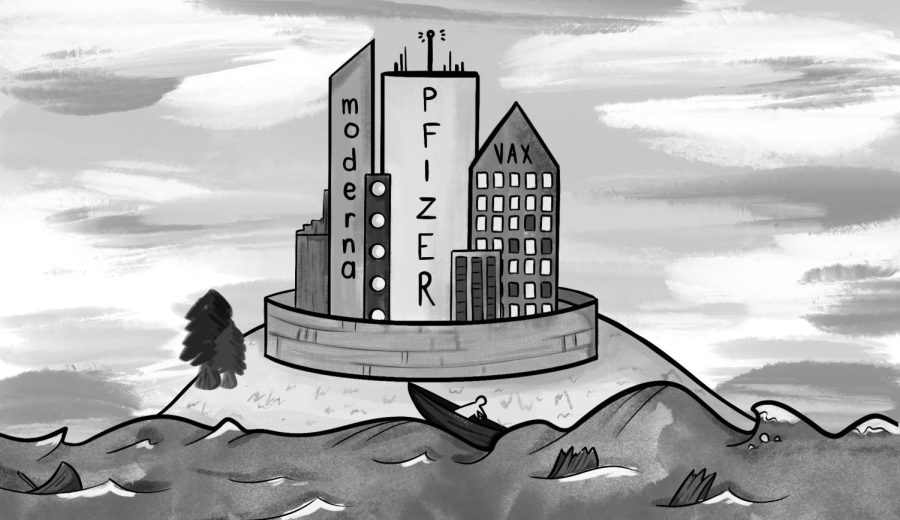Vaccine globalism, Claire-ified
Big pharmaceutical companies, Pfizer and Moderna, are taking over global vaccine distribution.
January 21, 2022
As the omicron wave surges to its crest, America and its high-income allies stand ready at the helm, confidently steering through the pandemic’s stormy waters. Protected by an abundance of vaccines, these countries have the wealth and infrastructure to withstand the tempestuous pandemic era. The rest of the world is meeting a different fate.
Engulfed in the wave’s icy turbine, countries without sufficient access to vaccines suffer higher mortality rates and economic fallout. Less than 5% of low-income countries’ populations have been vaccinated, compared to over 70% in high-income countries, according to Oxford University.
This vaccination rate disparity spells disaster for the fight to suppress variants and reduce the spread of COVID-19. The delta variant emerged before vaccines were approved, the lambda and mu variants surfaced in South America when the continent lacked access to doses and the omicron variant took root in South Africa, a country that only had a 25% vaccine rate when the variant was detected. Without a successful effort to make vaccines more widely available, we will likely face equally damaging and unpredictable variants in 2022.
At a time when expeditious vaccination on a global scale is both an immediate need and a prudent strategy, the world could not be falling further behind. The World Health Organization’s blueprint for combatting the pandemic centers on COVAX, a consortium that donates COVID-19 vaccines to countries that cannot purchase or manufacture them. This program has been a massive failure, distributing fewer than one billion doses—less than half of their goal—and relying on sporadic, ad hoc donations. The narrow scope and disorganized nature of its efforts have yielded tremendous waste: COVAX recently sent Nigeria one million nearly-expired vaccine doses, and only a small percentage of vaccines in the shipment reached the arms of citizens.
This deplorable underperformance should not be surprising—vaccine donation relies on COVAX as an unnecessary intermediary and puts low-income countries’ pandemic efforts in the hands of distant and uncooperative vaccine producers. To reduce the current COVID-19 case rate, preempt future variants and develop a global system that keeps us all safe, we need to enable and encourage vaccine production across the globe. This requires reducing intellectual property (IP) protections for COVID-19 vaccines. IP rights give vaccine producers the ability to prevent other companies from manufacturing their products. When countries issue patents for particularly innovative ideas, they give the patent holder a temporary monopoly—typically 20 years—in which the given company is the only one selling the product. This way, companies can charge high prices to recoup their investment in the research and development required to create and market the product.
Sometimes, an emergency necessitates government intervention during this temporary monopoly period so that a product can become widely available within a short time frame. Governments have various tools for handling these situations, but for COVID-19, the most important one is the compulsory license, which allows them to use issued patents and enable production by their own companies. Currently, compulsory licensing cannot become part of a viable strategy to quell the global pandemic because licenses are primarily limited to domestic use; countries cannot issue compulsory licenses to companies outside their territory, and they cannot issue compulsory licenses to companies within their territory if the product they are manufacturing is primarily for export.
These limitations on compulsory licensing are currently regulated by Article 31 of the Agreement of Trade-Related Aspects of Intellectual Property Rights (TRIPS). It was drafted and signed by the member nations of the World Trade Organization (WTO), which regulates global trade.
Reducing Article 31’s limitations on compulsory licensing is the best way to expand global vaccine production and distribution. Most low-income countries do not have the manufacturing capability to produce vaccines even if they could issue a compulsory license, but this is not necessary. Countries with strong pharmaceutical industries that can serve as regional manufacturing hubs—like India, South Africa or the Philippines—should be able to issue blanket licenses allowing their companies to manufacture vaccines patented by companies in the U.S. and Europe and export them to countries that do not have manufacturing capacity.
A limitation of IP rights, however, does not come without potential drawbacks: Compulsory licensing prevents companies like Pfizer or Moderna from controlling the market, and critics of IP reductions argue that this reduces the incentive to develop new technology in the first place. But unlike a complete waiving of IP rights, compulsory licensing preserves a majority of patent protections, only limiting them in the event of a global health emergency and maintaining companies’ right to be compensated with royalty payments. Domestic compulsory licensing and potential profit loss during an emergency are risks that are already assumed by vaccine producers, who are still able to make money from government contracts.
Moreover, the potential consequence of failing to provide this access is far greater than that of an IP reduction; with over five million recorded COVID-19 deaths worldwide and new variants raising the hospitalization and mortality rate each year, swift and direct action should be our first priority.
The situation becomes even more urgent in the context of China and Russia’s vaccine diplomacy programs, which distributed vaccines throughout Asia, Latin America and Africa. Many low-income countries are reliant on these free doses, but they are no longer effective. Neither the Chinese Sinopharm vaccine nor the Russian Sputnik vaccine uses mRNA technology, the crucial component that makes vaccines effective against the omicron variant. Consequently, American mRNA vaccines are the world’s only hope at breaking free from the pandemic; without mRNA vaccines, billions of people will have little to no protection against omicron and future vaccine-resistant variants, blocking any possible pathway towards public health and economic recovery. As America prepares to administer yet another round of booster vaccines, we must reconsider the sustainability and ethics of the nation’s pandemic strategy. If we truly intend on reducing COVID-19’s impact on our lives and industries, expanding access to vaccines is the only way forward.
The fight ahead will not be smooth sailing, but if we weather the storm together, the clouds will begin to part.






































